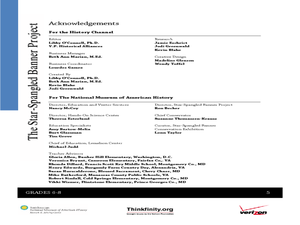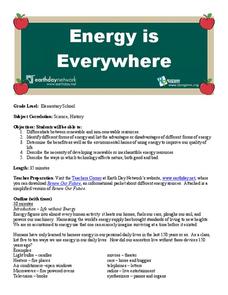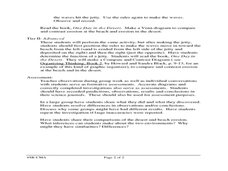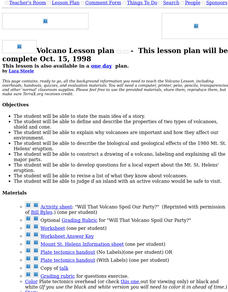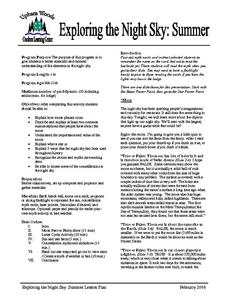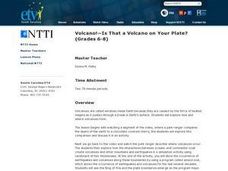Curated OER
Destructive Impact of Environment on Artifacts
Young scholars recognize that artifacts are destroyed over time. In this environmental factors on artifacts instructional activity, students experiment and observe through the microscope to find the environmental impact on...
Curated OER
Capillary Action and Adhesion
Students perform classroom experiments to observe adhesion. They perform a second experiment using sand, salt, water, and a heat lamp to observe the principle of capillary action. They also experiment with adhesion in plants.
Curated OER
Landscaping for Wildlife
Learners identify the essential elements needed for promoting wildlife habitat. They describe the terms used in habitat design and the shelter for wildlife. Students explore how to create a pond to support wildlife and how to create a...
Curated OER
Oklahoma's Berry Best
Ask your learners to complete activities related to Oklahoma's agriculture, berries in particular. The lesson is cross-curricular and has class members investigate an article about berries, write an acrostic poem, and discuss new...
Curated OER
Energy is Everywhere
Students differentiate between renewable and non-renewable resources and identify the different forms of energy and list the advantages or disadvantages of different forms of energy. They also determine the benefits as well as the...
Curated OER
Estuary Interviews
Students role play as newscasters to highlight the lives of estuary animals. In this estuary animal lesson, students watch local new shows to examine how interviews take place. They research the lives of animals that live in estuaries...
Curated OER
Daily Weather Calendar
Third graders use the internet to record the daily weather conditions. Using symbols, they take the information they gathered and create an easy to read chart. They share their charts with the class to end the activity.
Curated OER
Solar Power
Pupils discover how engineers use solar energy to heat buildings. They investigate the thermal properties of different materials. They evaluate the usefulness of each material.
Curated OER
For Your Eyes Only
Students identify two major types of visible pollutants, smog, and particulate matter, They explain that air pollutants are generated during incomplete combustion. They measure and rank collectors from the most pollutants to the least...
Curated OER
Label Your Body
Students assimilate the names of the parts of the body. They practice spelling body part words using a worksheet. They trace the outline of their bodies, add features and label the body parts from the vocabulary list.
Curated OER
Thinking Like a Scientist
Students explore the scientific method. Students identify the steps in the scientific method and explain what each step means. Students use these steps to determine if boys or girls are taller in their classroom.
Curated OER
The Physical Environment
Fourth graders use damp sand, a baking pan, and water to simulate erosion. For this erosion lesson plan, 4th graders participate in a simulation to show what moving water does to land.
Curated OER
Photosynthetically Available Radiation (PAR) Measurements
Students calculate the amount of solar radiation hitting the ground at their school compared to the solar constant. They also repeat the experiment at a water testing site and utilize a light probe to measure the light being reflected...
Curated OER
The Rain Maker
Second graders work in small groups with a cup each of several materials. Students layer the gravel, sand, and water into a resealable bag. They draw a picture of this bag in their water journal. Students place their sealed bags in a...
Curated OER
Climate and Temperature
Students explore what the soil temperature would be on the north and south sides of a building. In this temperature instructional activity, students hypothesize what the results will be using a thermometer and then after a week...
Curated OER
Breaking it Down
Students discover how water expands when frozen during a glacier. In this matter lesson, students fill a glass jar with water, leaving no room for air in the jar and place it in the freezer. Students retrieve the jar and notice the...
Curated OER
Food Chains
Young scholars create their own food chains on Kidspiration starting from the energy of the sun and what it creates. In this food chains lesson plan, students learn about how insects eat plants and so on.
Curated OER
Volcano Lesson Plan
Students describe the properties of volcanoes, and explain why volcanoes are important to the environment.
Curated OER
Air Quality and Transportation in the Tulsa Area
Students investigate the effects of air pollution. In this environmental instructional activity, students discuss the causes of air pollution and identify how transportation has an effect on the air quality. Students identify other...
Curated OER
Exploring the Night Sky: Summer
Students explain how moon phases occur. They describe and explain at least two common misconceptions that people have about the moon. Students explain what a star is. They explain 3 ways that the night sky has been used throughout history.
Curated OER
The Solar System: Go Green with the Sun!
Third graders learn how to use solar power. For this sun, technology and energy lesson, 3rd graders learn how the solar power from the sun can give off energy, learn about solar panels, discuss their uses and benefits, and design a...
Curated OER
Volcano! Is That a Volcano on Your Plate?
Students investigate where volcanos come from. In this volcano lesson plan, students watch videos do Internet research and participate in experiments to discover the cause of volcanos.
Curated OER
Life in a Cup
Third graders make and maintain a mini terrarium. They keep a daily journal of what happens in their terrarium and record daily observations and measurements.
Curated OER
Retrograde Motion
Students study the motions of the heavenly bodies. In this space instructional activity students use models to show a variety of schemes explaining the motions.


